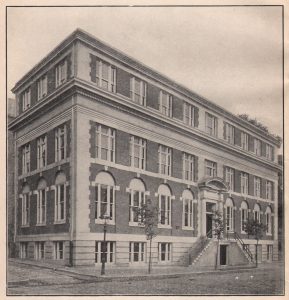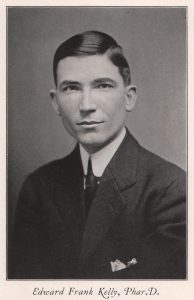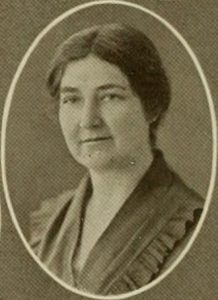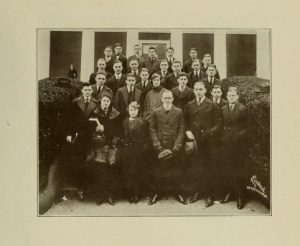The Health Sciences and Human Services Library Historical Collections’ strives to provide broad access to our diverse collections both in person and digitally. Materials in our collections appear as they originally were published or created and may contain offensive or inappropriate language or images and may be offensive to users. The University of Maryland, Baltimore does not endorse the views expressed in these materials. Materials should be viewed in the context in which they were created.

Photograph of the School of Pharmacy building located on the northeast corner of Lombard and Greene Streets. The building was built in 1904.
When the 1920 merger between the University of Maryland (Baltimore) and the Maryland State Agricultural School (College Park) occured the Department of Pharmacy became the School of Pharmacy. Like many of the schools in the University, the School of Pharmacy was coming off a low period in terms of admissions and graduates because of World War I. At commencement in May 1920 only 16 pharmacists graduated.
The academic year 1920-21 was a year of growth and advancement for the new school. The incoming class (of 1922) numbered 30 students, nearly double the graduating class of 1920. By the mid-1920s the graduating class would number 222. During the 1920-21 academic year, the school introduced new general education course requirements. The courses were English, modern language, physics and math and were taught by faculty from College of Arts and Sciences. A new course in business administration was also introduced to supplement an existing course in commercial pharmacy and store practice.
The School of Pharmacy was under the leadership of Dean, Dr. Edward Frank Kelly. Dr. Kelly came to the school as a laboratory assistant in 1902. He worked his way up to associate professor of in 1906 and became a full professor of Theoretical and Applied Pharmacy in 1917. Shortly after he was named dean of the school (1918), which he held until 1925. Dr. Kelly was also an integral part of the group that worked to merge the University of Maryland with Maryland State College to form the new State University in 1920.
Students in the School of Pharmacy, like most of the other professional schools, came mostly from Maryland and the surrounding states. The School of Pharmacy unlike many of the other professional schools at the university, explicitly welcomed women to the school as evidenced by the academic catalog, which was the only one to say, “Women are admitted to this College on the same basis as men.” As a result, it was one of few schools, to have a woman in the graduating class of 1921 and have three women students in the underclass. Additionally, it was the only school, except for the school of nursing, to have a woman faculty member.
B. Olive Cole was professor of botany, materia medica, pharmacognosy and vegetable histology and served a secretary of the faculty. B. Olive Cole was a 1913 graduate of the School of Pharmacy and went on to become one of the first women graduates of the school of law in 1923. She would later serve the School of Pharmacy as acting dean from 1948 to 1949 and is known as the “First Lady of Maryland Pharmacy.”
The traditional pharmacy student completed their education in two years, earning a Ph. G. (Graduate in Pharmacy) degree. In 1919, a new third-year plan was introduced allowing students to continue their education and earn a Ph. C. (Pharmaceutical Chemist) degree. Dr. John C. Krantz Jr. was the first graduate to receive a Ph. C. degree on May 26, 1920. Dr. Krantz was an associate professor in the 1920-21 academic year and would go on to discover drugs that drastically changed anesthesia.
In 1920 the costs associated with education in the SOP were a $5* matriculation fee, $140 tuition, a $5 breakage deposit, roughly $25 for books, $10 for chemical apparatus, and approximately $10 per week on room and board in the city. Additional fees included $18 Lecture courses, $5 review, and $16-25 labs. Admission to the two-year SOP included a certificate issued by State Department of Education. To receive the certificate applicants had to be at least 17 years old, have the equivalent of four-years high school education (in 1918 this requirement was raised from 2 years), and one year of Latin. To graduate students had to be at least 20 years old, attend at least two sessions at the SOP, pass a final examination in lecture and laboratory instruction, and pay the $10 graduation fee.
*Note: The equivalent of $1 in 1920 money is $12.96 in 2020 money; therefore, $5 in 1920 is $64.80 and $140 is $1814.40.
For more information on the SOP in 1920 please see:
- 1921 Terra Mariae Yearbook
- 1920-21 Academic Catalog
- A Legacy 175 Years in the Making History of the SOP
- A Short History of the Maryland College of Pharmacy (1841-1894) by Charles Schmidt, and, The Maryland College of Pharmacy and the School of Pharmacy, University of Maryland (1895-1946) by B. Olive Cole




